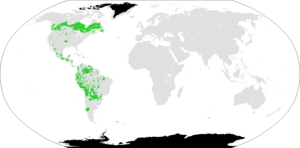Amerind languages
| Amerind | |
|---|---|
| (spurious) | |
| Geographic distribution |
New World |
| Linguistic classification | Proposed language family |
| Subdivisions |
|
| Glottolog | None |

Map of the area of Amerind languages.
|
|
Amerind is a hypothetical higher-level language family proposed by Joseph Greenberg in 1960 and elaborated by his student Merritt Ruhlen. Greenberg proposed that all of the indigenous languages of the Americas belong to one of three language families, the previously established Eskimo–Aleut and Na–Dene, and with everything else—otherwise classified by specialists as belonging to dozens of independent families—as Amerind. Due to a large number of methodological flaws in the 1987 book Language in the Americas, the relationships he proposed between these languages have been rejected by the majority of historical linguists as spurious.
The term Amerind is also occasionally used to refer broadly to the various indigenous languages of the Americas without necessarily implying that they are a genealogical group. To avoid ambiguity, the term Amerindian is often used for the latter meaning.
The idea that all the languages of the Americas are related goes back to the 19th century when early linguists such as Peter Stephen DuPonceau and Wilhelm von Humboldt noticed that the languages of the Americas seemed to be very different from the better known European languages, yet seemingly also quite similar to each other. When studies of American Indian languages began in earnest in the early 20th century linguists quickly realized that the indigenous languages were in fact not all that similar, but had a diversity much greater than among the languages of Europe. After a period of uncertainty about whether indigenous languages could be described and investigated by the methods applied to European languages, the first linguists began the daunting task of trying to classify the languages of the Americas by using the comparative method.
Among the most prolific and gifted linguists of his times was Edward Sapir, who was among the first to apply the comparative method to native American languages. However, contrary to current practice in historical linguistics, Sapir also often relied on "hunches" and "gut feeling" when proposing new language families. Some of these suggestions have been proven correct while others have not. Sapir entertained the idea that ultimately all languages of the Americas might turn out to be provably related and such a phenomenon as the apparent Pan-American tendency to have first person forms with a prefixed n- was suggestive for this line of thought.
...
Wikipedia
